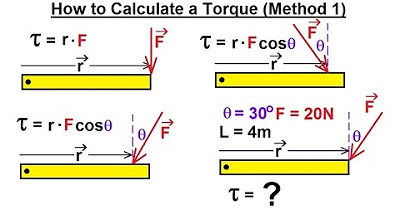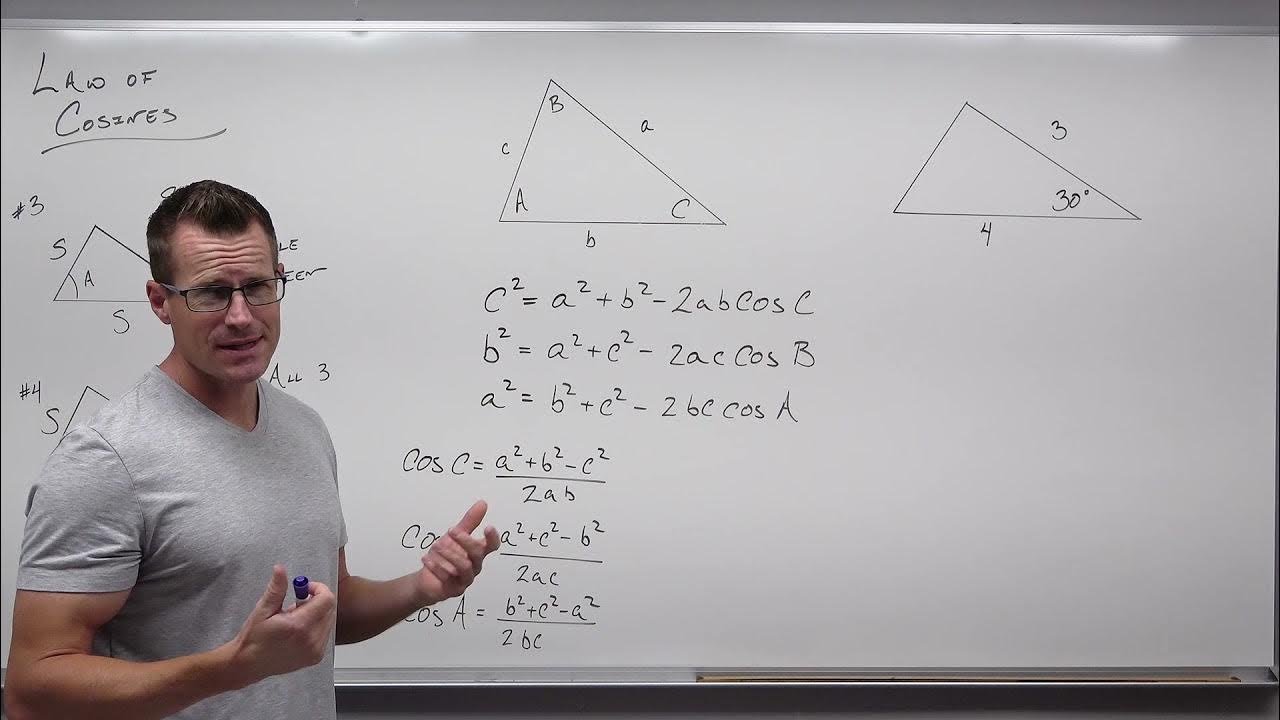5.6.3 Law of Cosines: Applications
TLDRIn this educational video, Mr. Banker explores the Law of Cosines through two distinct examples. First, he calculates the distance across a baseball diamond, using the law to find the length of a diagonal from the pitching rubber to the back corner of first base. The second example involves a regular tetrahedron, where the law is applied to determine the measure of a dihedral angle formed by the intersection of two faces. The video concludes with the calculation of the angle using the cosine formula, yielding an angle of approximately 70.53 degrees. This content is ideal for those interested in geometry and practical applications of mathematical laws.
Takeaways
- 🏞 The video discusses the application of the Law of Cosines in various geometric scenarios.
- 📏 The first example involves a baseball diamond, which is a square with 90-foot sides.
- 📐 The pitching rubber is 60.5 feet away from the home plate, and the video aims to find the distance from the middle of the pitching rubber to the back corner of first base.
- 🔢 The Law of Cosines formula is used with a 45-degree angle to calculate the unknown side length, resulting in approximately 63.72 feet.
- 🔺 A regular tetrahedron, a solid with four equilateral triangular faces, is the subject of the second example.
- 🔻 The dihedral angle, formed by the intersection of two faces, is to be measured in the tetrahedron example.
- 📐 The midpoint of an edge in the tetrahedron creates a 30-60-90 triangle, which helps in determining the lengths of segments within the shape.
- 📐 The Law of Cosines is again applied, this time to find the measure of angle B in the tetrahedron.
- 📘 The calculation involves squaring the lengths of the edges and using the cosine of angle B to find its measure.
- 📊 The final calculation reveals that the cosine of angle B is 1/3, leading to an angle measure of approximately 70.53 degrees using the inverse cosine function.
- 👋 The video concludes with a summary of the geometric problems solved using the Law of Cosines and thanks the viewers for watching.
Q & A
What is the main topic of the video?
-The main topic of the video is the application of the law of cosines in solving geometric problems.
What is the shape of a baseball diamond according to the video?
-The baseball diamond is described as a square with side lengths of 90 feet.
What is the distance from the pitching rubber to the back edge of home plate?
-The distance is 60 feet and 6 inches, which is approximately 60.5 feet.
What is the problem the video aims to solve using the law of cosines?
-The video aims to find the distance from the middle of the pitching rubber over to the back corner of first base, denoted as 'x' in the script.
What is the angle formed by the line running down the middle of the baseball diamond?
-The angle formed is a 45-degree angle because it splits the 90-degree angle at the corners of the square.
What is a regular tetrahedron according to the video?
-A regular tetrahedron is a solid with four faces, all of which are equilateral triangles.
What is a dihedral angle and what is its significance in the second example?
-A dihedral angle is the angle formed along the common edge of two intersecting faces in a solid. In the second example, the video seeks to find the measure of this angle in a regular tetrahedron.
What is the length of the edges of the regular tetrahedron in the video?
-The length of the edges of the regular tetrahedron is given as two units.
How does the video determine the lengths of the segments connecting the midpoint of an edge to the vertices of the tetrahedron?
-The video uses the properties of a 30-60-90 triangle to determine that these segments have lengths of the square root of 3.
What is the formula used in the video to find the measure of angle B in the tetrahedron?
-The formula used is B squared equals a squared plus C squared minus 2 times a times C times the cosine of angle B, rearranged to solve for the cosine of angle B.
What is the approximate measure of the dihedral angle B found in the video?
-The approximate measure of the dihedral angle B is about 70.53 degrees.
Outlines
📏 Baseball Diamond Measurement Using the Law of Cosines
In this segment, Mr. Banker introduces the application of the law of cosines to find a specific measurement on a baseball diamond. The diamond is described as a square with 90-foot sides, and the pitching rubber is 60.5 feet away from the back edge of home plate. The objective is to calculate the distance from the middle of the pitching rubber to the back corner of first base, denoted as 'x'. The problem is approached by considering the angles in the diamond, particularly the 45-degree angle formed by the straight line down the middle. Using the law of cosines formula, Mr. Banker demonstrates the calculation, resulting in an approximate distance of 63.72 feet.
📐 Dihedral Angle Calculation in a Regular Tetrahedron
The second paragraph delves into the concept of a regular tetrahedron, a three-dimensional shape with four equilateral triangular faces. The focus is on finding the measure of a dihedral angle, which is the angle between two intersecting faces. With edge lengths of two units, the midpoint of one edge is identified as point B. By connecting point B to the vertices of the two adjacent faces, a 30-60-90 triangle is formed, allowing for the calculation of the lengths of the sides adjacent to the dihedral angle. Using the law of cosines with the known side lengths and the angle B, the formula is rearranged to solve for the cosine of angle B. The calculation yields a cosine value of 1/3, leading to an angle of approximately 70.53 degrees using the inverse cosine function. This concludes the explanation of the dihedral angle measurement in a regular tetrahedron.
Mindmap
Keywords
💡Law of Cosines
💡Baseball Diamond
💡Pitching Rubber
💡Regular Tetrahedron
💡Dihedral Angle
💡Equilateral Triangle
💡Midpoint
💡30-60-90 Triangle
💡Inverse Cosine
💡Trigonometry
Highlights
Introduction to the Law of Cosines and its applications in geometry.
Exploring the baseball diamond problem with a square side length of 90 feet.
Calculating the distance from the middle of the pitching rubber to the back corner of first base.
Using the Law of Cosines with angle A to find the unknown side length x.
Result of x being approximately 63.72 feet, slightly less than 64 feet.
Transition to a regular tetrahedron with all faces as equilateral triangles.
Finding the measure of a dihedral angle formed along the common edge of two intersecting faces.
Identifying the edges of the tetrahedron to have a length of two.
Creating a 30-60-90 triangle by connecting midpoints of edges.
Calculating the lengths of the sides connecting midpoints to vertices as the square root of 3.
Using the Law of Cosines to find the measure of angle B in the tetrahedron.
Solving for angle B using the formula B squared equals a squared plus C squared minus 2AC times the cosine of angle B.
Calculating the cosine of angle B and finding its inverse to determine the angle.
Result of angle B being approximately 70.53 degrees.
Conclusion of the video with a summary of the findings.
Transcripts
Browse More Related Video

The Law of Cosines

Physics 15 Torque Fundamentals (4 of 13) How to Calculate a Torque (Method 1)

1-2 C Vector Addition - 2 (Parallelogram Method)

How to Use the Law of Cosines in Trigonometry (Precalculus - Trigonometry 33)

Law of Cosines, Finding Angles & Sides, SSS & SAS Triangles - Trigonometry

5.4.1 Double-Angle Identities
5.0 / 5 (0 votes)
Thanks for rating: